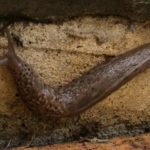The Slug
Slugs
Gastropoda

Has there ever been a creature so unloved and maligned as the humble slug. Walk into any garden centre and there will be a shelf of products on how to rid ourselves of this ‘pest’. Slimy, sticky and unloved, no ‘cuteness overload’ emoji goes with this mollusc, and yet they are wildlife on our doorstep and removing them can upset the whole natural ecological balance.
They provide food for other animals including birds, slow worms, earthworms and insects. Thrushes, as we know, particularly thrive on them. The poisoning of slugs and snails has had an accepted detrimental effect on our garden wildlife and yet we are still doing it. Most slugs are scavengers. They eat decaying organic matter, dead and rotting plants, leaf litter, fallen fruit, animal droppings, carrion and mouldering compost. They will naturally eat a row of newly planted lettuce, but as man inhabits and tries to tame more and more of the natural world there is going to have to be some give on our side.
The Leopard Slug, or Limax maximus, is a beautiful grey creature with leopard spot markings. Highly beneficial in the garden they are mainly active at night. This slug cleans up both dead plant matter and other slugs, moving at an impressive speed when in pursuit of its prey. The mating habits of the Leopard Slugare considered unusual among slugs, and worth reading up on!
As with other wildlife we have treated slugs as vermin in the past, think of this . . . ‘Before you step on a slug, or sprinkle the poison, pause and consider the creature’s marvellous complexity and place in the scheme of things’
Harriet English